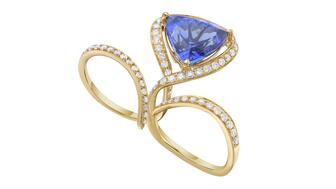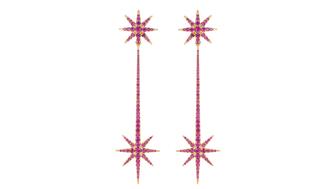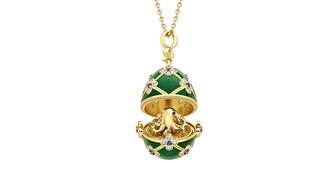Set in a Tiffany & Co. necklace, it sold for $4.2 million, the highest price and price per carat paid for a Paraíba tourmaline at auction.
50 Jewelers/50 States: Arkansas
In the latest edition of the 50 Jewelers/50 States series, Kevin Mays of Fort Smith store John Mays Jewelers shared how a humbling incident highlighted the necessity of jewelry education.

Fort Smith, Ark.-- Amid the changing and challenging retail environment, the editorial team at National Jeweler wondered how macro trends--from online shopping to serving new generations of consumers--have affected jewelers in disparate parts of the country.
In order to find out, we launched a series called 50 Jewelers/50 States, in which we interview one retailer in each of the 50 U.S. states.
The fourth installment features Fort Smith, Arkansas jewelry store John Mays Jewelers, a venture from husband-and-wife team John and Kathryn Mays and their sons, John IV and Kevin.
National Jeweler chatted with Kevin, who, along with his brother, is a bench jeweler and gemologist and will take over from his parents when they decide to retire.
Kevin shared his thoughts on the importance of social media and how a humbling incident with a knowledgeable customer enlightened him to the necessity of jewelry education.

National Jeweler: What’s the biggest challenge your store is facing?
Kevin Mays: One of the biggest challenges we face right now is (adapting to) millennials and keeping the traffic going while dealing with online competition.
The attention span has gotten shorter over the years. With baby boomers, it was a different way of selling. When my dad started selling in the 1960s it was to a totally different clientele than it is today.
People didn’t have online resources.
I wouldn’t say people were less educated then, but it’s a different form of education now. When you have a smartphone, before you walk in a place you can look up what they sell, you can look up prices, and before you didn’t have that capability.
You have to spark an interest for the new customers and social media plays a huge role in that.
NJ: What’s the top-selling item or brand at your store?
KM: Without a doubt, it’s Hearts On Fire. Anything Hearts On Fire--all of the jewelry, the diamonds. We pride ourselves on selling only ideal-cut diamonds and only Hearts On Fire. It’s the only true diamond line we carry in the store and we have since we’ve been in business.
NJ: Describe your regional customer.
KM: We’re getting a lot more bridal than we have in the past. With my brother and I being in the store now, we’re reaching out to a younger clientele and getting a new type of customer.
We have a higher-end clientele in our area. We’re definitely a couture store; we sell nicer, higher-end pieces. We’ve always prided ourselves on stocking quality not quantity.
Our customers are probably 60 percent women and 40 percent men. A lot of women now are making their own purchases. They’re coming in and buying themselves things.
They’re rewarding themselves for career advancements or having a new child or different things going on in their lives whereas before I think it was more men rewarding the women. Now, women are rewarding themselves. We still have quite a few men come in as well.
NJ: What’s the most popular style of engagement ring with your clientele?
KM: Definitely still a halo with a round center stone. Cushion-top or a round-top, either one. A lot of the cushion-tops with the round centers have been very, very popular with us.
And, of course, still your basic solitaire. People come in every day and they’ve had that image in their heads since they were little girls that they wanted a 1-carat solitaire. That image that several companies put out in the past still rings true today.
We do a lot of white gold and a lot of platinum as well. We like to sell platinum. It’s an heirloom-quality-type metal. It’s a noble metal and a pure metal so we push platinum but we do sell a lot of 18-karat white gold as well.
Yellow gold is starting to make a comeback in our area but it’s nothing near what platinum and white gold do.
NJ: What’s your internet and social media presence like? What accounts do you have or actively use?
KM: We do a lot with Facebook and Instagram. Instagram, I think, is where it’s really at for us. It’s very picture-oriented, it’s very right now. You have about a 30-second window when people scroll through to find the image that captures their point of interest.
When people are looking through Instagram maybe they’re looking for a vacation or cars or motorcycles or surfing--something they like to do. If you’ve been thinking about a jewelry piece or a watch or engagement ring and you see a picture of one, then you’re automatically going to stop and if that image is captivating to a person, then that will get them to click through to your page and start following you and that translates into sales.
We’ve only been doing Instagram since we moved into our new store last September. I started playing with Instagram and Snapchat. Snapchat didn’t work for our particular store but Instagram started taking off and we’ve actually seen some follows turn into dollars in our store.
I try to post a couple of times a day, at least once a day. You can follow the analytics on your page, and it will tell you when people are looking. I’ve started paying attention to that, when people are on your page, what times of day--seeing when people are liking and tagging your stuff and then playing into that.
NJ: What are your thoughts on e-commerce?
KM: We don’t have e-commerce at this time, but we’re looking into it right now. It’s a possibility. I’ve been speaking with our web designer and looking at Shopify and a few other e-commerce platforms, playing with the idea of it.
E-commerce works for some brands and for others, it won’t work. As a whole, if you’re not looking into it, I think you’re going to miss the boat with the next generation.
NJ: What’s the best piece of advice you’d offer to other independent jewelry stores?
KM: Education is key. You have to know what you’re selling, know the product. We’re a firm believer in GIA and AGS and that you have to have your degrees and know what you’re selling. I don’t know how people can sell a product that they don’t quite understand.
When I went into this business I was kind of naïve to how important education was. After getting my graduate jeweler and graduate gemologist degree, I realized the importance of them.
Before I had my gemology degree, I had a customer who came into the store one day and pretty much raked me over the coals on a strand of pearls, pretty much took me to school. So when I went to school I thought, “I’m never letting this happen again. I’m going to know what I’m selling when that customer comes back in.”
When the customer left that day, I was beat down, I had my tail between my legs, and I just didn’t know how I could go on. The first course I took after that was my graduate pearls degree. When he came in that next time I could tell him what depth of water the pearls were farmed at, what farm they came from, the name of each of the different oysters--I was ready for it.
I ended up selling him a strand of pearls.
So I think education and knowing the product and the gems and minerals that we sell is key. A lot of GIA grads call ourselves gem geeks and we are gem geeks, that’s why we’re in this business.
NJ: What’s a fun fact about you we can share with our readers?
KM: Before I got into the jewelry industry I raced motorcycles professionally so I come from a different background. I went from going fast and living an adrenaline-filled life to going at a much slower pace.
The Latest

The jeweler’s “Deep Freeze” display showcases its iconic jewelry designs frozen in a vintage icebox.

Take luxury gifting to new heights this holiday season with the jeweler’s showstopping 12-carat sphene ring.

How Jewelers of America’s 20 Under 40 are leading to ensure a brighter future for the jewelry industry.

This year's theme is “Unveiling the Depths of the Ocean.”


In its annual report, Pinterest noted an increase in searches for brooches, heirloom jewelry, and ‘80s luxury.

Starting Jan. 1, customers can request the service for opal, peridot, and demantoid garnet.

Roseco’s 704-page catalog showcases new lab-grown diamonds, findings, tools & more—available in print or interactive digital editions.

The 111-year-old retailer celebrated the opening of its new location in Salem, New Hampshire, which is its third store in the state.

The new catalog features its most popular chains as well as new styles.

The filmmaker’s personal F.P. Journe “FFC” prototype was the star of Phillips’ recent record-setting watch auction in New York.

The new location in the Design District pays homage to Miami’s Art Deco heritage and its connection to the ocean.

“Longtime favorite” presenters, as well as first-time speakers, will lead talks and workshops at the annual event in Tucson next year.

Silas Smith of Meridian Metalworks won the challenge with his pendant that blends Australian and American landscapes.

The sale of the 31.68-carat, sunset-hued stone was part of Sotheby’s first series of events and auctions in Abu Dhabi.

Most customers who walk into your store this month have made up their minds. Your job is to validate their choice, Emmanuel Raheb writes.

The collection features characters and motifs from Ukrainian folklore, including an enchanted mirror and a magic egg.

MatrixGold 3.11, the newest version of the jewelry design program, offers more flexibility, precision, and creative control.

The pavilion will be part of the 2026 JA New York Spring show, scheduled for March 15 to 17.

Kadet, a 1994 National Jeweler Retailer Hall of Fame inductee, helped grow the family-owned retailer in the Chicago area and beyond.

Billed as the world’s smallest wearable, Lumia Health’s new smart earrings have a health tracker subtly embedded in the back.

Don’t let those with December birthdays feel blue. Help them celebrate their month with blue zircon, turquoise, and tanzanite.

The new pink sapphire version of the piece dances with its wearer in the brand’s “Icons After Dark” holiday campaign.

A choice that’s generated a lot of commentary, Pantone says “Cloud Dancer” marks a fresh start and encourages relaxation and creativity.

The manufacturer’s holiday campaign features a gift guide filled with trending designs and jewelry that can be personalized.

The man was charged with theft, accused of ingesting the necklace while in a jewelry store in Auckland, New Zealand.

The Florida independent expanded its store from 8,000 to 14,000 square feet, fulfilling the vision of its late co-founder, Jim Dunn.




























